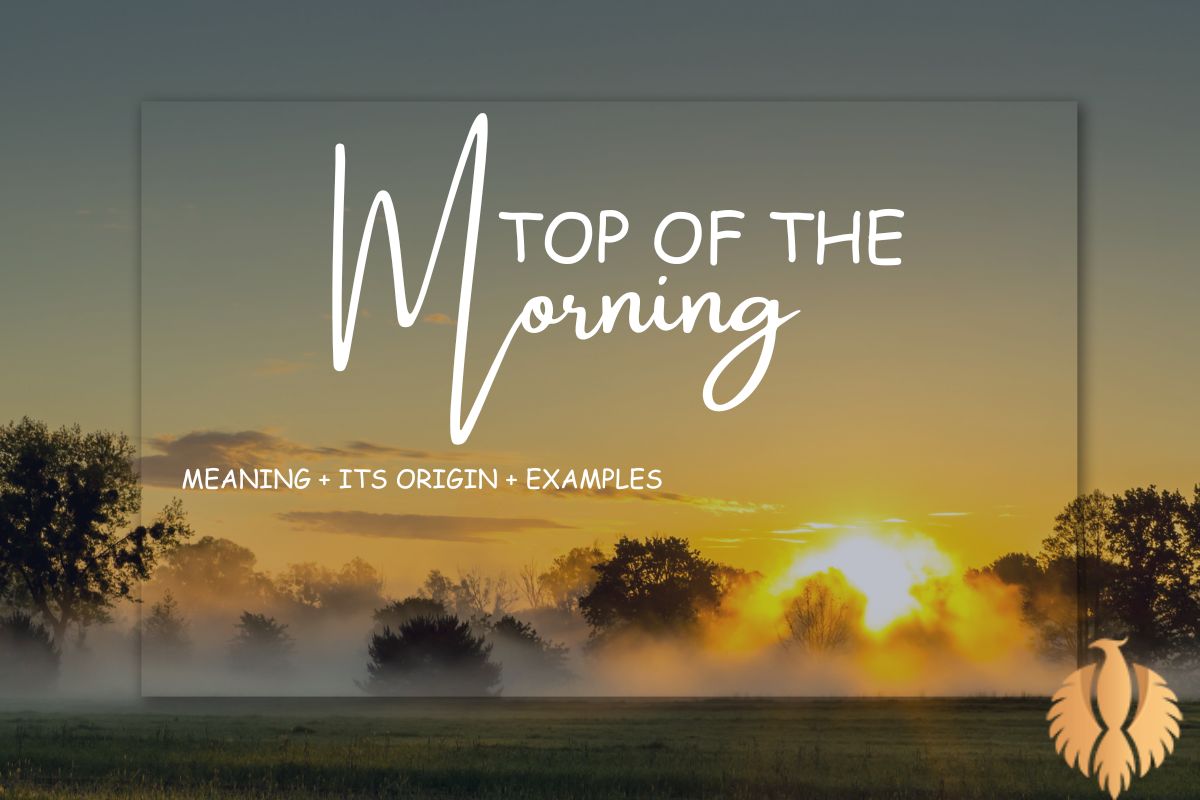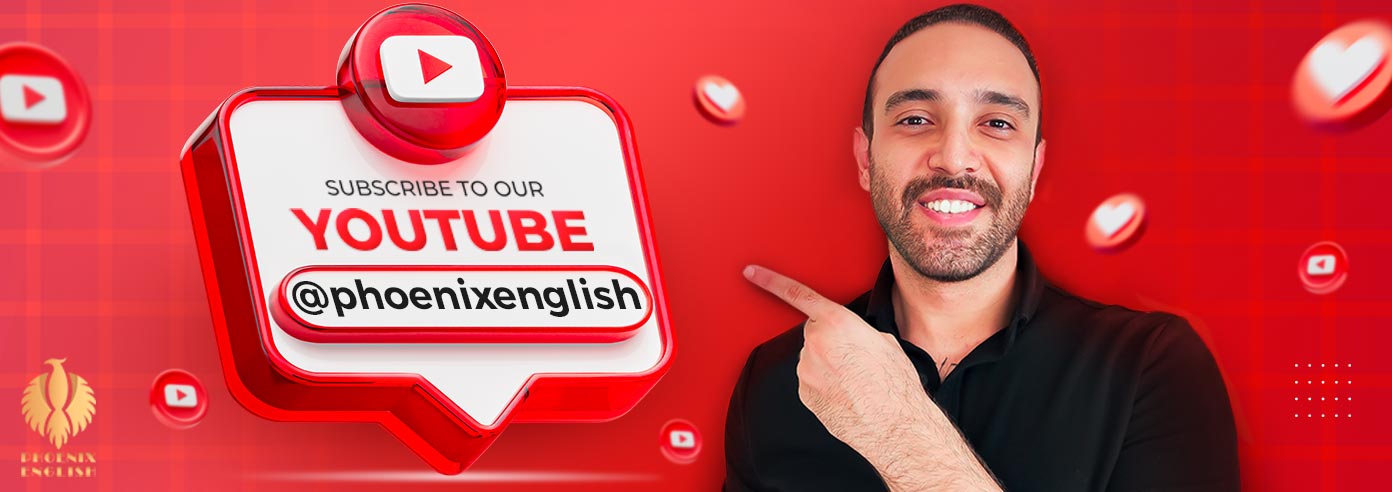The phrase “Top of the morning” is a traditional Irish greeting that means “good morning” or “greetings at the start of the day.” It is often used as a cheerful, informal way to say hello or wish someone a pleasant morning. This idiom conveys a warm and friendly tone, making it a delightful way to start conversations.
![infographic about Top of The Morning – Meaning + Its origin + Examples [2025]](https://phoenixenglishlang.com/wp-content/uploads/2024/01/unnamed-2.png)
“Top of the morning” originates from Irish culture and has been used for generations as a way to express goodwill and positivity at the beginning of the day. Although it is not as commonly used in contemporary English, it remains a charming expression that reflects the rich cultural heritage of Ireland.
In this article, we will explore the meaning, origin, and usage of the idiom “Top of the morning.” We will also provide examples to illustrate how it can be incorporated into your daily interactions. By understanding and using this phrase, you can add a touch of Irish charm to your greetings and enhance your conversational skills.
You might also enjoy: Top 100 Commonly Used Verbs That Start With D [2024]
Where does “Top of the morning” come from?

Here are 30 points about the phrase “Top of the morning” and its origins:
- **Irish Origin**: The phrase is commonly associated with Irish culture and is often thought to be an Irish greeting.
- **Traditional Greeting**: It is used as a way to wish someone a good start to the day, akin to saying “Good morning.”
- **Historical Usage**: The phrase has been in use since at least the 19th century, particularly in literature and folk expressions.
- **Folklore Context**: In Irish folklore, the phrase was used by characters as a friendly or jovial greeting, enhancing its cultural significance.
- **Media Popularity**: The phrase gained popularity through literature, theater, and later films, contributing to its widespread recognition.
- **Exaggerated Usage**: Some believe it’s an exaggerated stereotype of how Irish people speak, popularized in media portrayals.
- **Connection to “Mornin'”**: “Top of the morning” suggests the peak or best part of the morning, emphasizing positivity.↕️
- **Variations**: Variations of the phrase exist in different cultures, albeit not always with the same wording.
- **Cultural Stereotype**: It has become somewhat of a cultural stereotype, sometimes considered cliché outside of genuine Irish context.
- **Famous Print**: The phrase appears in various forms in newspapers and advertisements from the early 20th century.
- **Use by Famous Figures**: Figures such as actors and comedians have popularized the phrase, linking it with good cheer and humor.⌨️
- **Debates on Authenticity**: Linguists and historians debate whether it is genuinely an old Irish expression or more of a romanticized concept.
- **Catchphrase in Media**: It has been used as a catchphrase in TV shows, cartoons, and movies to evoke a whimsical or friendly character.️
- **Connection to “Luck”**: The phrase is sometimes linked to the idea of good luck, as starting the morning on a positive note is favorable.
- **Beyond Ireland**: While often thought of as Irish, similar phrases exist in other cultures, suggesting a universal desire to wish well in the morning.
- **Modern Usage**: Its use has somewhat declined in contemporary conversation but remains a nostalgic or humorous saying.
- **Adoption in English**: The phrase was adopted into English-speaking contexts, often stripped of its Irish roots.
- **Cultural Celebrations**: It may be used during St. Patrick’s Day celebrations as part of showcasing Irish culture.
- **Social Media**: The phrase occasionally resurfaces on social media as a charming way to greet followers.
- **Variations in Tone**: Depending on the context, it can be used sincerely or lightheartedly, showcasing varying social norms.
- **Impact on Language**: The phrase illustrates how language evolves and adapts through cultural exchange and media representation.
- **Associated Expressions**: Other expressions like “Good day” or “Have a good one” carry similar meanings.
- **Playful Nature**: Its playful tone adds a layer of friendliness, making it popular in informal settings.
- **Literary References**: Authors, especially in Irish literature, have used the phrase to capture the essence of Irish vernacular.
- **In Film and Television**: Iconic characters in shows have helped in popularizing the phrase, often in comedic settings.
- **Misinterpretation**: Some people misunderstand it as a common Irish phrase, whereas actual everyday usage in Ireland is less frequent.
- **Culinary References**: It has also been whimsically used in food and beverage advertising to evoke a cheerful morning atmosphere.
- **National Identity**: The phrase contributes to the stereotype of the Irish as cheerful and optimistic.
- **Declining Popularity**: Despite its charm, “Top of the morning” rarely appears in contemporary conversations among Irish people.
- **Legacy**: Today, it remains a beloved phrase for many, summoning a sense of nostalgia associated with Irish culture and friendliness.
Where is “Top of the morning” used?
In terms of usage, “top of the morning” is often used as a standalone phrase to greet someone or wish them a good morning.
While it has its roots in Irish culture, it has spread beyond Ireland and is used in various English-speaking countries as a friendly and informal morning greeting.
It is often perceived as a cheerful and positive way to start a conversation or acknowledge someone at the beginning of the day.
You might also enjoy:Looking Forward To Seeing You: Grammar + Examples[2025]
I’m going to show you how to respond to “Top of the morning”?

When someone greets you with “top of the morning,” a common response is to say “and the rest of the day to you!” This is a traditional Irish greeting and response.
If someone says “top of the morning to you” as a stereotypical remark, it is often associated with Irish culture or leprechauns. In this case, you can respond with a light-hearted comment or a simple “hello” to acknowledge the greeting. However, it’s important to remember that stereotypes can be offensive, so it’s best to approach the situation with respect and sensitivity.
The phrase “top o’ the morning” is often associated with Irish culture and is commonly believed to be an authentic Irish greeting. However, it is actually a Hollywood invention and not a commonly used phrase in Ireland. In reality, Irish people typically greet each other with a simple “hello” or “good morning.”
The phrase became popularised through films and media, perpetuating the stereotype of Irish people as always saying “top o’ the morning.” While it may be used in a playful or lighthearted manner, it’s important to recognise that it is not an accurate representation of Irish culture.
It’s always best to approach cultural stereotypes with respect and understanding, recognising that they often do not reflect the reality of a particular group of people.
Top of the morning Myth or Reality?
Few dialect myths rankle more people than the purported Irish phrase, “top o’ the morning.” Any Irish person will inform you that they have never, ever heard even one of their countrymen utter these words. So where did the greeting come from, and why is it so ubiquitous in popular culture?
Like many such terms, “top o’ the morning” appears to be more archaic than outright apocryphal. Snooping around some old threads at the Daltai forum, commenters provide fascinating examples of the greeting in literature. For example, this poem from Henry Newbolt, written during World War I (emph. mine):
So I laughed, and felt quite well disposed to the youngster,
And shouted out “the top of the morning” to him,
And wished him “Good sport!”—and then I remembered
My rank, and his, and what I ought to be doing:
And I rode nearer, and added, “I can only suppose
You have not seen the Commander-in-Chief’s order
Forbidding English officers to annoy their Allies
By hunting and shooting.”
From the context of the poem, you may notice that Newbolt is English, rather than Irish. This would suggest that “top o’ the morning” was heard in various parts of the British Isles. Regardless of how widespread the phrase once was, it doesn’t seem exclusive to Hiberno-English.
Then there’s this quote, from the oddly-titled novel Knocknagow – The Homes of Tipperary, written by Irish author Charles J. Kickham in 1879:
They were met by the “man of the house” before they reached the kitchen door, and as he gave a hand to each, Father Hannigan’s hearty “Good-morrow, Maurice,” struck Mr. Lowe as being admirably in keeping with his appearance. And the words —”The top of the morning to you, Miss Grace,” suggested the idea that Father Hannigan affected the phraseology of the peasantry.
So it appears “top o’ the morning” was indeed spoken in the Victorian era (at the latest), although Kickham suggests that the phrase was already something of an affectation. While I can’t put a date on when “TotM” started to recede, a rough guess might put its extinction at some point in the early 20th-Century. Just how widespread the phrase was (if ever) is unclear to me.
To be honest, though, I’m not terribly interested in when “top o’ the morning” disappeared from Irish English so much as how this phrase entered the American consciousness. What in popular culture gave us the idea that “top o’ the morning” is the standard Irish “hello?”
One popular theory blames the famous Lucky Charms Leprechaun from American television ads. But the evidence is shaky. It doesn’t seem that anyone Irish was involved in the original ad campaign (the man who voiced the Leprechaun wasn’t even of Irish descent). When the campaign first ran, in the early 1960’s, it’s likely that Americans already associated “top o’ the morning” with Irishness.
I’d guess, then, that the myth originates with an earlier source, perhaps a film for which the screenwriter had an unusually nuanced understanding of Hiberno-English. The Quiet Man might be a candidate, as it was co-written by an actual Irishman, Maurice Walsh. That being said, I haven’t seen the film in years and can’t say if the phrase is even anywhere in the script.
You might also enjoy:Emersion Vs Immersion: Meaning, Differences, and Examples
I suggest these alternatives for “Top of the morning”

“Top of the morning” is an informal greeting that originated in Ireland. It is often used as a friendly and casual way to say “good morning.” However, if you are looking for more formal alternatives, here are some options:
- Good morning
- Greetings
- Hello
- Good day
- Good morning, [person’s name]
- How do you do?
- It’s a pleasure to see you
- I hope you’re having a pleasant morning
- I trust you had a restful night
- May your morning be filled with joy and productivity
- Wishing you a pleasant start to the day
- I hope this morning finds you well
- Good morning, esteemed colleagues
- Good morning, ladies and gentlemen
- I hope you’re having a wonderful morning
- I extend my warm greetings to you this morning
- I hope your day is off to a great start
- I wanted to wish you a good morning
- I hope you’re feeling refreshed and ready for the day
- Good morning, dear friends and colleagues.
You Might Also Enjoy: Top 60 Most Common Simple Sentences In English
I’m going to give you 30 examples with “Top of the morning”

- “Top of the morning! How are you today?”
- “Just wanted to stop by and wish you a top of the morning!”
- “Rise and shine! Top of the morning to you!”
- “Good morning, everyone! Top of the morning!”
- “As the sun rises, I wanted to wish you a top of the morning!”
- “Hey there, neighbour! Top of the morning to you!”
- “Starting the day with a smile and a top of the morning to all!”
- “Coffee’s brewing, birds are singing, and it’s the top of the morning!”
- “Sending you a virtual hug and a top of the morning to brighten your day!”
- “Wishing you a productive and joyful day ahead. Top of the morning!”
- “May your day be filled with blessings and opportunities. Top of the morning!”
- “Gentle reminder: It’s a brand-new day. Top of the morning, my friend!”
- “Sending you positive vibes and a top of the morning from across the miles!”
- “Let’s start the day on a positive note. Top of the morning, my dear!”
- “No matter what the day brings, remember that you’re amazing. Top of the morning!”
- “The world is your playground today. Top of the morning and go conquer it!”
- “Waking up to a beautiful sunrise and wishing you a top of the morning!”
- “Every day is a fresh start. Top of the morning, and make it count!”
- “Embrace the new day with open arms. Top of the morning, lovely!”
- “Feeling grateful for another day of opportunities. Top of the morning, world!”
- “The best way to start the day is with a smile. Top of the morning, sunshine!”
- “Sending you a burst of positivity and a top of the morning to kickstart your day!”
- “Remember to take a moment for yourself. Top of the morning and self-care!”
- “Wishing you a day filled with laughter and joy. Top of the morning to you!”
- “May your day be as bright as the morning sun. Top of the morning, my dear!”
- “Start the day with gratitude and watch the magic unfold. Top of the morning!”
- “Sending you a virtual high-five and a top of the morning from afar!”
- “No matter what challenges come your way, remember you’re capable. Top of the morning!”
- “Embrace the opportunities that today holds. Top of the morning and seize the day!”
- “Wishing you a day filled with love and happiness. Top of the morning to you and yours!”
“Top of the morning” in conversation

- Person A: Top of the morning to you!
Person B: Good morning! How are you today?
- Person A: Top of the morning!
Person B: Morning! Did you sleep well?
- Person A: Top of the morning, my friend!
Person B: Good morning! What’s on your agenda for today?
- Person A: Top of the morning, mate!
Person B: Morning! How’s the weather looking today?
- Person A: Top of the morning, sunshine!
Person B: Good morning! Ready to tackle the day?
- Person A: Top of the morning, beautiful!
Person B: Morning! How did you sleep?
- Person A: Top of the morning, champ!
Person B: Good morning! Any exciting plans for today?
- Person A: Top of the morning, buddy!
Person B: Morning! How’s everything going?
- Person A: Top of the morning, pal!
Person B: Good morning! Did you have a good weekend?
- Person A: Top of the morning, my love!
Person B: Morning! How are you feeling today?
- Person A: Top of the morning, partner!
Person B: Good morning! Ready to conquer the day?
- Person A: Top of the morning, my dear!
Person B: Morning! How was your night?
- Person A: Top of the morning, my favourite person!
Person B: Good morning! How’s everything going?
- Person A: Top of the morning, my rockstar!
Person B: Morning! Did you have a good rest?
- Person A: Top of the morning, my sunshine!
Person B: Good morning! How’s your day looking?
- Person A: Top of the morning, my bestie!
Person B: Morning! Any exciting plans for today?
- Person A: Top of the morning, my partner in crime!
Person B: Good morning! How are you feeling today?
- Person A: Top of the morning, my favourite human!
Person B: Morning! How was your weekend?
- Person A: Top of the morning, my superstar!
Person B: Good morning! Ready to take on the day?
- Person A: Top of the morning, my amazing friend!
Person B: Morning! How’s everything going with you?
You might also enjoy:How Are You Fairing or Faring? Differences + Examples
Frequently Asked Questions
- What does the phrase “Top of the morning” mean?
“Top of the morning” is an informal greeting used to wish someone a good start to their day, similar to saying “Good morning,” but with a cheerful and lighthearted connotation.
- Where does the phrase “Top Of The Morning” Originate?
The phrase is believed to have originated from Ireland, where it was used as a friendly salutation among people.
- When did “Top of the morning” first appear in written records?
Written records of the phrase date back to the 19th century, particularly in Irish literature and folk expressions, although it likely existed in spoken form prior to that.
- Is there any specific cultural significance associated with “Top of the morning”?
Yes, it embodies Irish hospitality and the importance of wishing others well at the start of the day, reflecting the friendly nature of Irish culture.
- How is “Top of the morning” perceived in modern times?
In contemporary contexts, it is often viewed as outdated or a cliché. While it can be used humorously, it is rarely employed in everyday conversation in Ireland.
- Can “Top Of the Morning” be used at any time of the day?
Traditionally, it is meant for the early hours of the morning. Using it later in the day may be viewed as playful or ironic rather than sincere.
- Are there variations of “Top of the morning” in other cultures?
Many cultures have their own morning greetings, such as “Bonjour” in French or “Buongiorno” in Italian, but “Top of the morning” is unique to Irish vernacular.
- How has media influenced the popularity of “Top of the morning”?
Media portrayals, particularly in films and television, have popularized the phrase, often using it for comedic characters, thus embedding it in popular culture.
- Can you provide an example of “Top Of the Morning” in a sentence?
“As she stepped into the room, she greeted everyone with a cheerful, ‘Top of the morning to you all!’”
- Was “Top of the morning” ever used in political contexts?
While primarily a casual greeting, it has occasionally appeared in political speeches or events to invoke warmth and camaraderie.
- Is “Top of the morning” commonly used among Irish people today?
It is not commonly used in everyday conversation among younger generations of Irish people, who tend to favor simpler greetings.
- What is the tone of “Top of the morning”?
The tone is generally cheerful, lighthearted, and optimistic, aimed at fostering a friendly atmosphere.
- How does “Top of the morning” relate to Irish hospitality?
The phrase reflects the essence of Irish hospitality, where greetings are an important social ritual, serving to make connections and foster goodwill.
- Have notable figures used “Top of the morning”?
Yes, public figures, especially comedians and entertainers, have used the phrase in performances, reinforcing its connection to Irish charm.
- Are there any other sayings similar to “Top of the morning”?
Yes, expressions like “Rise and shine,” “Morning, sunshine,” or “Good day” convey similar sentiments, though they lack the specific cultural flair of the Irish phrase.
- Is “Top of the morning” used in advertisements?
It has occasionally been used in advertisements, especially for Irish brands or products, to evoke a sense of cheerfulness and cultural authenticity.
- What impact did globalization have on the phrase?
Globalization has introduced “Top of the morning” to wider audiences, often presenting it as a charming representation of Irish culture in international contexts.
- Has “Top of the morning” ever been parodied?
Yes, the phrase has been subject to parody in different forms of entertainment, often highlighting Irish stereotypes or exaggerating its whimsical connotation.
- Is “Top of the morning” used by younger generations?
It is largely unfamiliar to younger generations in Ireland, who generally prefer more modern or straightforward greetings.
- In what contexts can you genuinely use “Top of the morning” today?
It can be used in informal settings with friends, during themed events celebrating Irish culture, or as a lighthearted greeting to evoke nostalgia and cheerfulness.
Results
By now you should be an expert on the phrase “top of the morning”. This Irish phrase is an alternate way to greet someone in the morning.
Although it originated from Irish culture, this phrase has been adopted by many English-speaking countries as a way to say good morning.

Hi, welcome to my blog! My name is Omid and I am thrilled to have you here! I am an English language teacher with 12 years of experience and hold multiple international certifications (TESOL, IELTS, TOEFL, PTE, CELTA). Additionally, I hold a PhD in Applied Linguistics with a specialization in Teaching English as a Second Language (TESL), which fuels my passion for teaching English and assisting others in mastering the language. To me, nothing is more rewarding than helping individuals enhance their English language abilities through various methods. So, let’s embark on this journey of learning English together.





One Comment
You didn’t mention song from Mike Olldofield – Top of the morning. This is very beautiful melody.